+Search query
-Structure paper
| Title | A human monoclonal antibody binds within the poliovirus receptor-binding site to neutralize all three serotypes. |
|---|---|
| Journal, issue, pages | Nat Commun, Vol. 14, Issue 1, Page 6335, Year 2023 |
| Publish date | Oct 10, 2023 |
 Authors Authors | Andrew J Charnesky / Julia E Faust / Hyunwook Lee / Rama Devudu Puligedda / Daniel J Goetschius / Nadia M DiNunno / Vaskar Thapa / Carol M Bator / Sung Hyun Joseph Cho / Rahnuma Wahid / Kutub Mahmood / Scott Dessain / Konstantin M Chumakov / Amy Rosenfeld / Susan L Hafenstein /  |
| PubMed Abstract | Global eradication of poliovirus remains elusive, and it is critical to develop next generation vaccines and antivirals. In support of this goal, we map the epitope of human monoclonal antibody 9H2 ...Global eradication of poliovirus remains elusive, and it is critical to develop next generation vaccines and antivirals. In support of this goal, we map the epitope of human monoclonal antibody 9H2 which is able to neutralize the three serotypes of poliovirus. Using cryo-EM we solve the near-atomic structures of 9H2 fragments (Fab) bound to capsids of poliovirus serotypes 1, 2, and 3. The Fab-virus complexes show that Fab interacts with the same binding mode for each serotype and at the same angle of interaction relative to the capsid surface. For each of the Fab-virus complexes, we find that the binding site overlaps with the poliovirus receptor (PVR) binding site and maps across and into a depression in the capsid called the canyon. No conformational changes to the capsid are induced by Fab binding for any complex. Competition binding experiments between 9H2 and PVR reveal that 9H2 impedes receptor binding. Thus, 9H2 outcompetes the receptor to neutralize poliovirus. The ability to neutralize all three serotypes, coupled with the critical importance of the conserved receptor binding site make 9H2 an attractive antiviral candidate for future development. |
 External links External links |  Nat Commun / Nat Commun /  PubMed:37816742 / PubMed:37816742 /  PubMed Central PubMed Central |
| Methods | EM (single particle) |
| Resolution | 2.5 - 3.15 Å |
| Structure data | EMDB-27943, PDB-8e8l: EMDB-27947, PDB-8e8r: EMDB-27948, PDB-8e8s: EMDB-27949, PDB-8e8x: EMDB-27950, PDB-8e8y: EMDB-27951, PDB-8e8z: |
| Chemicals |  ChemComp-PLM: |
| Source |
|
 Keywords Keywords | VIRUS/IMMUNE SYSTEM / Complex / Fab / poliovirus / neutralizing / VIRUS-IMMUNE SYSTEM complex |
 Movie
Movie Controller
Controller Structure viewers
Structure viewers About Yorodumi Papers
About Yorodumi Papers




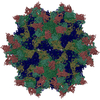

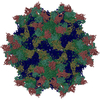



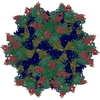

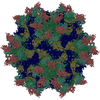

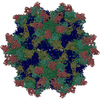

 human poliovirus 1 mahoney
human poliovirus 1 mahoney homo sapiens (human)
homo sapiens (human)